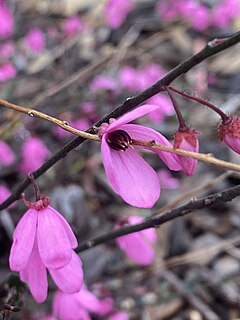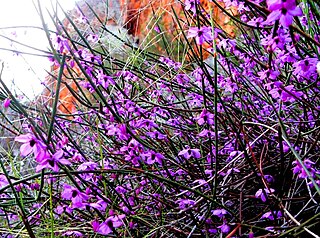
Tetratheca is a genus of around 50 to 60 species of shrubs endemic to Australia. It is classified in the botanical family Elaeocarpaceae, now known to encompass the family Tremandraceae, which the genus originally belonged to. It occurs throughout extratropical Australia, and has been recorded in every mainland state except the Northern Territory.

Hakea orthorrhyncha, commonly known as bird beak hakea, is a shrub which is endemic to the Murchison River area of Western Australia.

Tetratheca hirsuta, commonly known as black-eyed Susan, is a small shrub in the family Elaeocarpaceae. Endemic to the south-west of Western Australia, it is not related to other plants known as black-eyed Susan around the world.

Tetratheca ciliata, commonly known as pink bells, is a small shrub in the family Elaeocarpaceae. It is endemic to southern Australia.

Persoonia filiformis is a species of flowering plant in the family Proteaceae and is endemic to the south-west of Western Australia. It is a small, erect shrub with hairy young branchlets, linear leaves and greenish yellow flowers borne singly or in groups of up to twenty on a rachis up to 30 mm (1.2 in) long.
Goodenia filiformis, commonly known as thread-leaved goodenia, is a species of flowering plant in the family Goodeniaceae and is endemic to near-coastal areas of south-western Western Australia. It is an erect to ascending herb with cylindrical to narrow linear leaves at the base of the plant and racemes of yellow flowers.
Tetratheca paynterae, also known as Paynter's Tetratheca, is a species of plant in the quandong family that is endemic to Australia. There are two recognised subspecies.
Tetratheca deltoidea, also known as granite tetratheca, is a species of plant in the quandong family that is endemic to Australia.
Tetratheca similis is a species of plant in the quandong family that is endemic to Australia.
Tetratheca retrorsa is a species of plant in the quandong family that is endemic to Australia.
Tetratheca remota is a species of plant in the quandong family that is endemic to Australia.
Tetratheca fasciculata, also known as Cronin's Tetratheca, is an extinct species of plant in the quandong family that was endemic to Australia.
Tetratheca setigera is a species of plant in the quandong family that is endemic to Australia.
Tetratheca pilata is a species of plant in the quandong family that is endemic to Australia.
Tetratheca phoenix is a species of flowering plant in the quandong family that is endemic to Australia.
Tetratheca exasperata is a species of flowering plant in the quandong family that is endemic to Australia.
Tetratheca nephelioides is a species of plant in the quandong family that is endemic to Australia.
Tetratheca pubescens is a species of flowering plant in the quandong family that is endemic to Australia.
Tetratheca harperi, also known as Jackson Tetratheca, is a species of flowering plant in the quandong family that is endemic to Australia.

Tetratheca aphylla, also known as the Bungalbin Tetratheca, is a species of flowering plant in the quandong family that is endemic to Australia.





